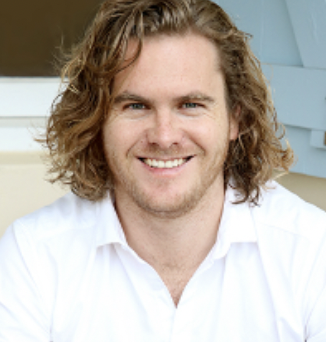You may know Pita Taufatofua as the "shirtless flag bearer"— because he carried Tonga’s flag shirtless when he competed in the 2016 Olympics for taekwondo. He then competed again in the 2018 Winter Olympics for cross-country skiing.
Now, in the 2020 Olympics, he’s once again competing in taekwondo but also hoping to add sprint kayaking to his resume—attempting to make history as the first athlete in the modern Olympic era to have competed in three entirely different sports.
Given Pita’s Olympic success and ability to so fearlessly chase down his goals, we spoke with him to hear his key lessons for others wanting to do the same.
1. Self-reflection is an important first step when chasing your goals.
If you’ve set a goal but are afraid to go after it, Pita recommends starting with self-reflection. You certainly don’t want to "look at the dragon inside" of you "because that’s a little bit scary."
Instead, you want to uncover what’s holding you back. Is it the negative messaging received as a kid telling you you can’t achieve your goal? Maybe it’s the current messaging.
Regardless of the reasons, self-reflection will help you become better at listening to your heart.
2. Listen to your heart.
Pita started listening to his heart from a young age, having been brought to tears by an Olympic video he watched in his university library at age 18 (more on that in a minute).
Needless to say, there’s a lot we can learn from Pita on the topic, starting with the importance of drowning out unhelpful negative voices.
"With this [listening to your heart], we’ve got voices around us that try to ground us. You know [voices that say], ’I’m worried about you. I’m worried that if you don’t accomplish that, you’re going to feel disappointed. I love you a lot. I don’t want you to feel that disappointment.’ These are voices from people who care. Then, we’ve got voices from other people who want to put us down in some way."
Pita recommends drowning these voices out and listening to your heart over anyone else. But what exactly does listening to your heart entail?
It involves listening to the voice inside you that draws you to something greater than yourself despite what others may say. "It’s about understanding the things that make you who you are and that pull you towards that goal or dream," explains Pita. "It’s an individual answer to this question. It’s about understanding yourself, first and foremost."
Pita acknowledges that this process isn’t easy. After all, people struggle with it either because they’ve never taken the time to do it or aren’t sure how to access their heart. But it can be done.
In Pita’s case, he vividly recalls an event that pulled him towards his dream and allowed him to better understand himself. All he had to do was listen and act.
"So I’m a mechanical engineer by study. I did my engineering and masters at the University of Queensland [Australia]. One day I was in the library, and I went and pulled out a VHS—it was called "Olympian Pursuing the Dream. I put it into the TV and sat there in the library and watched it.
It showed all of these Olympians. It didn’t show everyone who was winning, but it showed people who were overcoming odds. During the marathon, for example, someone’s hip or knee or something would break, and they’d find a way to finish and overcome [the odds].
And I sat there crying. This is an 18-year-old male who’s a martial artist, and I just sat there. There’s nothing else that moves me the way humans move me when they overcome challenges. I thought that must be a part of what my purpose is meant to be."
3. There is always a way.
Pursuing a goal won’t always be plain sailing. Sometimes you’ll have to adapt and adjust your strategy to achieve it. Pita understands this. That’s why he carries the following mantra with him into every challenge or goal he pursues: "There’s always a way."
It’s just up to you to find it.
"We have the idea that when we’re pursuing a goal, we have to go through the front door," says Pita. "Sometimes the front door is shut. So, what do we do? We go and we try the back door. Sometimes the back door is shut. So, we go and we look for the window. The window is too high, or the window is shut. We climb the wall and we go through the chimney and if there is no chimney, we break down the wall."
4. Do things anyway because your greatest joy will come from those things that draw you toward your goals.
Pita has written a book on motivation called "The Motivation Station." And because he’s written a book on the topic, people often assume he’s a motivated person. But Pita, like you and I, is human. He also has days when he doesn’t feel like training or isn’t motivated to get out of bed.
"It’s something I have to overcome each and every day. There are days when "I want to stay in bed; I want to eat this food; I want to sleep more; I want to watch that movie and do nothing all day. But the difference is that these moments don’t last very long. The time it takes me to overcome them is seconds."
Pita takes the approach of doing things anyway despite not always wanting to. And he does it with a smile on his face because he’s motivated by the realization that "Our greatest joy comes from finding those things that draw us towards them [our goals]."
5. Never give up.
For the most part, you shouldn’t ever give up on your dreams. However, Pita accepts that you still need to be practical, cut your losses, and move on if your dream is genuinely not attainable.
"If I’m trying to recreate a blockbuster VHS system where I rent out movies, and that’s my dream, it probably won’t work because we’ve already moved to DVDs, streaming and Netflix."
Unfortunately, many people don’t give up because their dreams are impractical. They give up long before they should because things get hard. Sadly, they don’t realize they’re often on the brink of achieving something amazing.
Pita, who is also a private coach to people wanting to overcome life challenges, has seen this first hand—and he calls this Donkey Kong Principle.
Yes, Donkey Kong is a Nintendo video game where a giant gorilla steals a princess and tries to stop you from saving her by throwing barrels and other objects at you.
"In the last level, Donkey Kong throws all the barrels at you; throws everything," explains Pita. "It’s like the final king in a game. This is when people stop. When everything is going wrong, people say, ’Maybe this dream isn’t for me. Maybe it’s too much.’ What they don’t see is that they’re on that last level. Things get harder, progressively harder and harder. The closer you are to achieving your dream, the more barrels get thrown at you. Keep going!"
6. Be wary of burnout—and treat it as a shared responsibility.
While not giving up and relentlessly chasing down your goals is certainly a noble endeavor, try not to burn yourself out in the process: a reality for many athletes and high performers.
The good news is you can avoid burnout and properly manage it if it occurs. The key is to treat it as a "we" problem—and share the responsibility. Pita explains through his experience working in social services with young homeless people.
"It is our responsibility to look after ourselves and our mental and physical health, but also the mental and physical health of those around us—to understand the signs of someone who’s struggling a little bit and just to ask them, ’How is everything? Do you need a few days? I’m happy to take that load; things are going great for me.’
And what happens is that it comes back tenfold. We had fantastic outcomes just because we were able to share the load of things that were going on with people and try and recognize burnout long before it happened."
Related reading: To learn more about burnout, how it impacts the employee experience, and how you can prevent and better manage it, read How employee experience impacts customer experience, where we speak to workplace happiness and burnout expert Jennifer Moss.
7. Learn resilience and tenacity because you fail your way to success.
People have this misconception that achieving success is a series of wins when, in reality, it’s a series of failures.
This means, you need to be tenacious and resilient when pursuing your dreams. "Resilience is what’s going to allow you to achieve your goal," explains Pita.
"Something I really want to get across to people is that you fail your way to success. Achieving a goal is a series of failures, followed by learnings, followed by more failures, followed by more learnings from the failures.
You don’t necessarily always win because the universe doesn’t allow you to. Anything worthy of achieving—any goal or dream—is going to require Donkey Kong throwing carts at you and for you to keep on going right through it."
Go get those goals
Chasing down your goals and dreams isn’t easy. You will face obstacles along the way. In many cases, these may simply be the voices in your head. But it can be done—you can achieve your goals.
Just take one small step at a time. Start with self-reflection and then follow all the other lessons from Pita to guide you along the way and help you drown out the voices, become more resilient, and never, ever give up. In the words of Pita, "Keep going!"
Written by Nick Darlington
Originally Published: 19 August 2021



